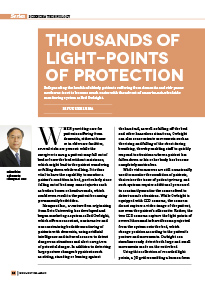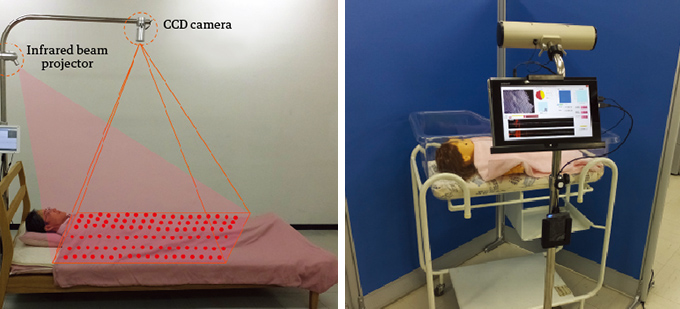Home > Highlighting JAPAN >Highlighting Japan September 2015>Science & Technology
Highlighting JAPAN

Science & Technology
Thousands of Light-Points of Protection
Safeguarding the health of elderly patients suffering from dementia and risk-prone newborns is set to become much easier with the advent of a non-invasive bedside monitoring system called Owlsight.

When providing care for patients suffering from dementia, either at home or in eldercare facilities, several risks are present: while the caregiver is away, a patient may fall out of bed or leave the bed without assistance, which might lead to the patient wandering or falling down while walking. It is thus vital to have the capability to monitor a patient’s condition in bed, particularly since falling out of bed may cause injuries such as broken bones or head wounds, which could even result in the patient becoming permanently bedridden.
Ideaquest Inc., a venture firm originating from Keio University, has developed and begun marketing a system called Owlsight, which offers noncontact, noninvasive and nonconstraining bedside monitoring of patients with dementia, using artificial intelligence and infrared sensors to detect dangerous situations and alert caregivers of potential danger. In addition to detecting large posture changes by patients such as sitting, standing or leaning against the handrail, as well as falling off the bed and other hazardous situations, Owlsight can also sense minute movements such as the rising and falling of the chest during breathing, thereby enabling staff to quickly respond to situations where a patient has fallen down or his or her body has become completely motionless.
While videocameras are still occasionally used to monitor the condition of patients, that raises the issue of patient privacy, and such systems require additional personnel to constantly monitor the camera feed to detect unsafe situations. While Owlsight is equipped with CCD cameras, the cameras do not capture a video image of the patient, nor even the patient’s silhouette. Rather, the two CCD cameras capture the light points of several thousand infrared beams projected from the system onto the bed, which change position according to the patient’s posture and movements. Owlsight can simultaneously detect both large and small movements made on the entire bed.
Using this collection of recorded light points, a 3D grid resembling a human form is reconstructed. An artificial intelligence system (neural network) judges whether the patient is exhibiting a safe posture or a dangerous one. If any changes occur, immediate alerts signifying “safe,” “verification required,” or “danger” are immediately transmitted to the caregiver, allowing a single caregiver to care for several patients at a time. Since patients do not sense that they are being watched, they can spend their time normally, without being conscious of the existence of the monitoring equipment.
“Generally speaking, in Europe, to protect patients’ privacy, it is forbidden to film them using cameras,” says Ideaquest CEO Mitsuhiro Sakamoto. “Even filming their outline or silhouette is often avoided or prohibited entirely. Owlsight equipment, on the other hand, is capable of monitoring an individual’s posture with the use of infrared light points without infringing on the patient’s privacy.”
Sakamoto explains another of Owlsight’s merits. “Since infrared light-point information requires a remarkably lower volume of data compared to image data, backups can be maintained for longer periods of time, and can be conveniently transferred via smartphones as well.”
Ideaquest has started projects for installing a similar system in bathrooms and toilets to protect elderly persons living by themselves. “The majority of deaths of persons living alone happen during sleep, in the toilet or in the bath, as a result of a stroke or heart attack,” Sakamoto reports. “If detected early enough, however, it is possible to save their lives. By installing this system in these high-risk areas, I hope we can make it possible to alert someone immediately when a dangerous situation is spotted.”
The system’s capability to sense even minute movements such as breathing has led to other developments, including diagnostic equipment to detect sleep apnea syndrome, equipment for diagnosing swallowing functions, and devices for gathering information on the breathing patterns of newborn infants. These systems have also attracted significant attention overseas, and some European and Asian countries are considering using them.
As an advanced nation experiencing a decreasing birthrate and aging population, the trends in Japan have attracted global interest. It is believed that this technology for protecting anyone from newborn infants to the elderly can solve some of the issues facing society at large.
© 2009 Cabinet Office, Government of Japan






